
If you’ve been watching my Instagram stories, you’ll probably know that I’ve been on an elemental diet of late. An elemental diet, for the uninitiated, is basically a hospital style pre-digested formula that you sip instead of ingest through a tube. Being unable to eat has meant I’m unable to work, and while Netflix and bed days have been fun, I’m ready to get back in the kitchen/game. Because I have already published my gluten free egg pasta recipe, this gluten-free beetroot pasta dough was an obvious way to do that.
Why? Because I already know the pasta works and tastes good. Because beetroot pasta is a fun, pretty and exciting project to wile away lockdown. Also? Just because.
Gluten-free beetroot pasta dough
This gluten-free beetroot pasta dough is (obviously) gluten free, but also nut free and FODMAP friendly. We’ll get into the FODMAP content of beetroot and your options in the FODMAP section below.
Does this gluten-free beetroot pasta taste like beetroot?
I’m sure you’ll inevitably wonder if the gluten-free beetroot pasta actually tastes like beetroot. According to my valued taste tester (given I cannot currently eat pasta) the answer is no. You won’t get an overwhelmingly earthy flavour from this pasta. If anything, you might taste a hint of earthiness, particularly if you eat the pasta plain. However, the subtle flavour is such that you could probably get away with feeding this pasta to a beetroot hater, particularly if you put sauce on it.

Gluten-free beetroot pasta dough and FODMAPs
There’s really only one FODMAP niggle to discuss, and that’s the beetroot itself. Fear not, however! We have plenty of options for tailoring the pasta to your needs. Let’s jump in.
Beetroot is FODMAP friendly in 20g serves per person, which is not a lot. This gluten-free beetroot pasta dough contains 100g of beetroot. However, depending on the heartiness of the sauce you use, it serves about 6 people.
If you are concerned with the amount of beetroot, I have successfully tested the pasta with 50g as opposed to 100g. This would place the pasta well within FODMAP limits, even if you eat more than 1/6th of it.
That said, the pasta with 50g of beetroot loses a considerable amount of colour while it cooked. That’s the main reason I added more – to minimise the colour loss in the cooking process.
If you use 50g of beetroot, the cooked pasta will be a pale-ish pink in colour. Still very pretty and fun, but less vibrant than when it was dough. Mind you, the 100g beetroot version loses a bit of colour too – it just remains a little more vibrant than the 50g version. See the cooked pasta photo below for an indication. How much you’d like to add is up to you.

How to prepare your beetroot
Washed and trim small beetroots (leaving the skin on) and rub a tiny bit of olive oil onto them. Then, wrap the beetroots individually in some alfoil.
Preheat the oven to 180C or 365F. You can also pop the beetroots in the oven alongside other things, if you’ve got stuff cooking. They don’t take up much room.
Cook the beetroots for around an hour, or until a knife slides through without meeting any resistance. Remove the beets from the oven, and allow to cool completely. You might want to unfurl the foil to minimise condensation as they cool.
You can use the beetroots once cooled, or pop them in the fridge for another day. I’d suggest using them within 2-3 days.
To use the beetroots, peel away the skin and cut them into small-ish chunks. Place them in a high speed blender, along with the eggs. This is why the beetroot needs to be completely cooled – so it doesn’t cook the eggs as they blend together.
Keep blending until the mixture is mostly smooth, being careful not to heat the eggs up too much. Depending on your processor, this might mean having a few blending breaks so as not to overheat them.
Once smooth, you’re done! You are ready to add this beautifully vibrant beetroot egg mixture to flour and make pasta dough.

Gluten free beetroot pasta ingredient notes
- For notes on beetroot, see above.
- I ALWAYS use extra large eggs. This is particularly important for things like this pasta, where the eggs are the binder, fat and liquid source.
- You all know that I don’t recommend xanthan gum unless it is truly, absolutely necessary. In brownies? No way. Cookies? Can do without it. Cake? Nah. But in pasta, xanthan gum is a super important ingredient. Not only does it assist in strength, elasticity and stretch (think of it as a gluten replacer) it will generally make your life so much easier. I haven’t tried this recipe without it.
- I used brown rice flour, but you can also use white rice flour, if that’s all you can find. HOWEVER! DO NOT USE a gritty, thick rice flour. Because there are so few ingredients in this recipe, it will create an unpleasant result. In Australia, I always recommend the health food brands over the supermarket boxed variety, which is very gritty. These days the health food aisle of the supermarket should have a better quality than the box, but health or bulk food store is best. There is honestly a huge difference in taste and texture.
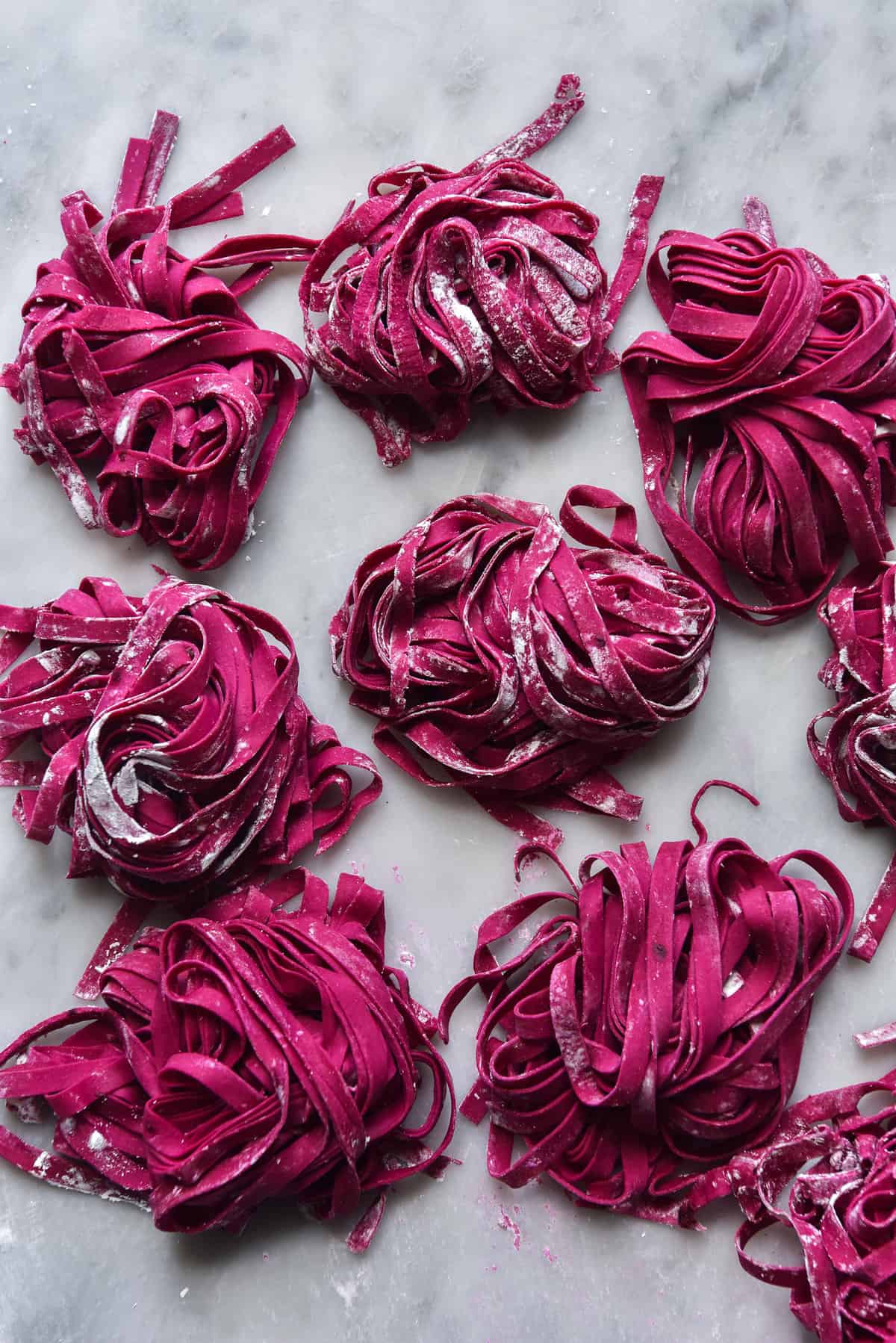
Equipment notes
- I have a Jamie Oliver pasta machine which I googled to give you a link (it’s an inexpensive, super old machine so I wanted to prove you could do it with the basics) but everyone seems to hate on their Jamie pasta machine in the reviews. Personally mine works fine, but maybe consider shopping around for another brand of inexpensive machine.
- As I’ve mentioned elsewhere, I find a rolling pin useful to get the pasta thin enough to put through the machine in the first place. It’s not compulsory, but it is very helpful.
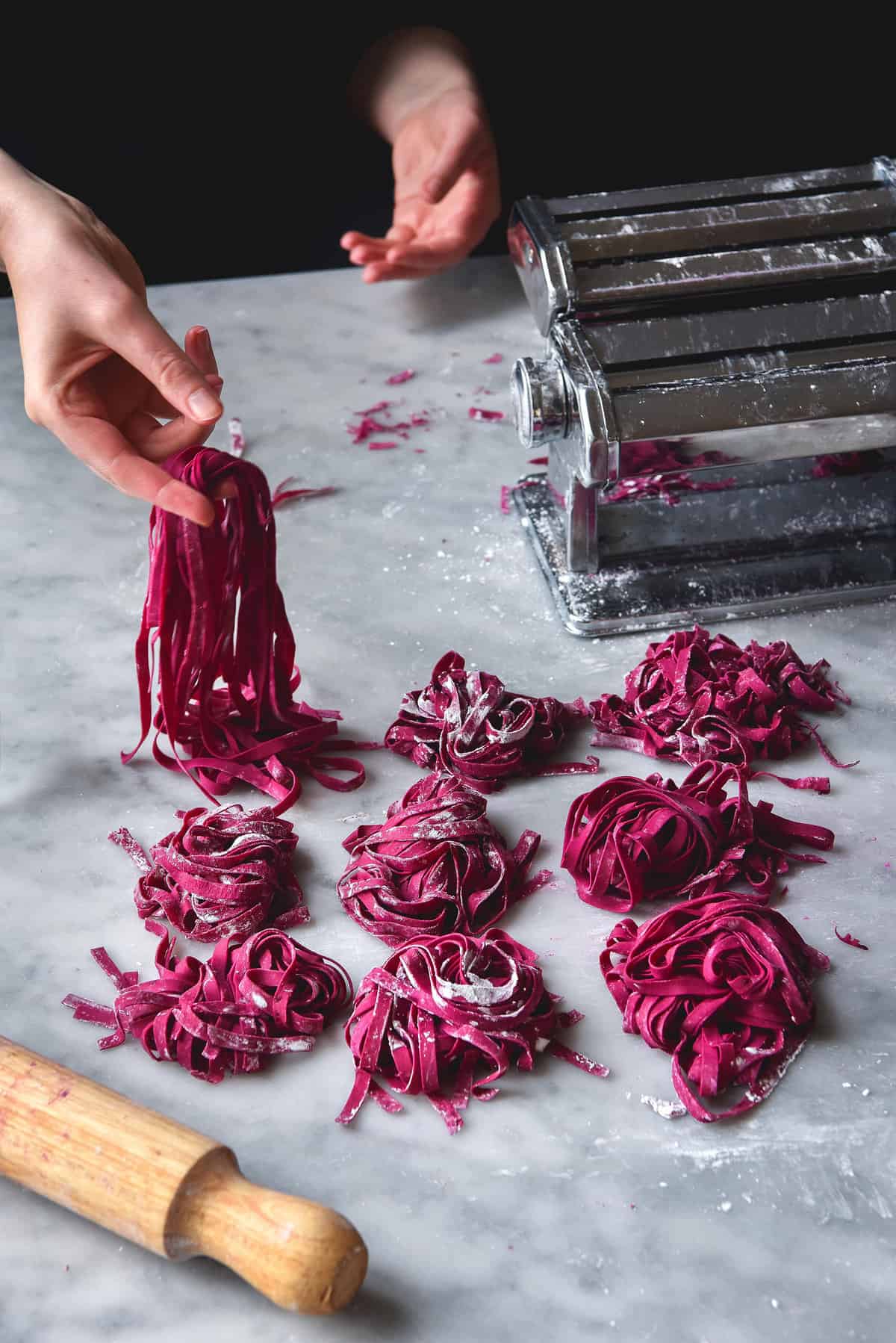
Gluten free pasta rolling notes
The aim of the game is to have the dough wet enough to form a relatively smooth ball, without being so wet that you have to ply it with flour to roll out. When and if you’re adding extra liquid, really question if you NEED that liquid or you’re just being lazy in kneading it together. Trust me, your life will be a lot easier in the long run if you put in the work early on. Wet pasta needs a lot of flour to roll out, and it also constantly tears or sticks to the machine. This means you’ll need to keep flouring it and re-rolling, which can add up to double to the rolling time (and make your pasta too starchy).
Patience is key! Pop on a podcast and relax into the rolling out process. Using a pasta machine, it takes about 30-40 minutes to roll and cut the pasta at a semi-leisurely pace.
If the pasta has little tear marks, it’s too wet. Easy solution – add a little extra tapioca flour and try again. Always start on the thickest setting and gradually move to thinner settings. If you go from a 7 (thickest on my machine) to a 1 (thinnest) instantly, the pasta will probably be shredded up completely or torn in large segments. It’s all about slowly thinning it out.
I have only tried a fettuccine style pasta with this dough. Although it successfully cuts into an angel hair style, I find it’s best in it’s cooked form as a fettuccine. It does make a great ravioli with a few adjustments – I’ll be sharing that recipe soon.
If you’re a visual learner: here’s a simple Delicious video that will show you show to roll out pasta.

A note on beetroot bits
A quick note on beetroot bits in your gluten-free beetroot pasta dough. Unless you spend eleventy hundred years blending, you will probably have little beetroot bits in your dough. This is fine – it’s pretty! But it does require a little extra attention.
Because the beetroot bits are necessarily wet, they need a little extra TLC as they go through the pasta machine. Key takeaway: just make sure any beetroot bits have a dusting of flour on them before they go into the pasta roller. Wet pasta dough is a headache to roll out and often gets stuck in the machine. A little light dusting of flour can help prevent that.
On the note of beetroot bits, it’s probably prudent to mention that each pasta dough will be a little different, pending the liquid content of the beetroot, size of the eggs, etc. My top tip for pasta making is to not be lazy and really work it before adding more liquid, if it’s absolutely necessary. You might think you’re cutting a corner by adding extra liquid, but it will really just make your life miserable when it comes to rolling it out. Only as much liquid as humanly necessary.
I found this beetroot pasta dough a little drier in ball form than I did the regular pasta dough. As long as the ball comes together and isn’t heinously dry, you’ll be fine. It softens and becomes more supple the more you run it through the pasta machine.
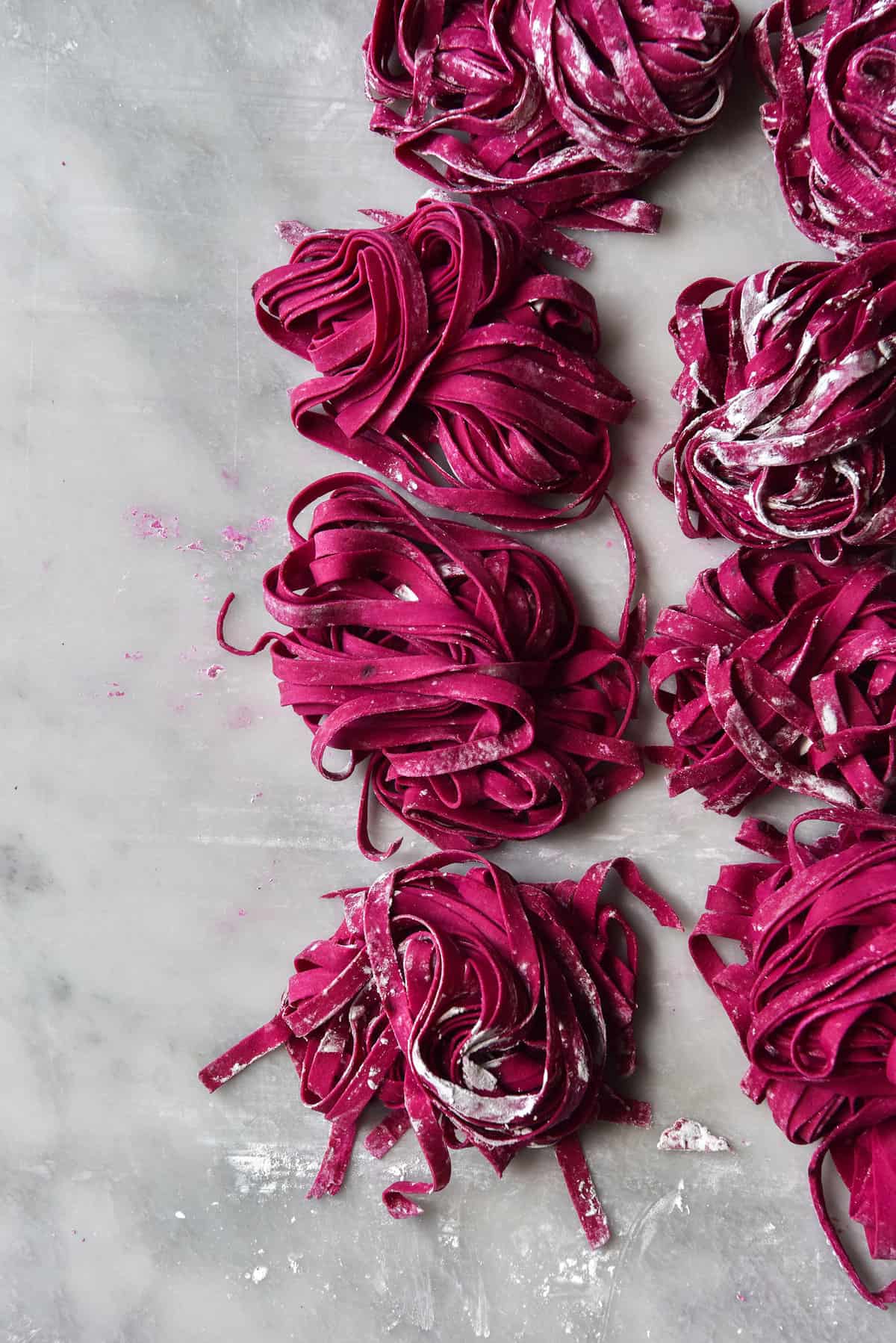
Notes on xanthan gum
As I’ve mentioned earlier in the piece, I don’t generally recommend xanthan gum unless it’s totally, absolutely necessary. Personally, I think it’s really overused in lots of gluten free baking applications that don’t truly require it. So, please believe me when I say it is an absolute godsend in gluten free pasta making.
Adding xanthan gum to this gluten-free beetroot pasta dough adds an elasticity that would be impossible to achieve without it. This is particularly important here, given that we have replaced one of the eggs in the original recipe with beetroot.
If you’re new to pasta making or are attempting to make pasta without a machine, I recommend adding a little extra xanthan gum. It will result in a more cohesive dough that is a bit more resilient and can be rolled thinner than it’s xanthan-less counterparts.
I haven’t tried this recipe without xanthan gum, so if you’re hell bent on doing that you will be experimenting. Let me know how it goes if you do!
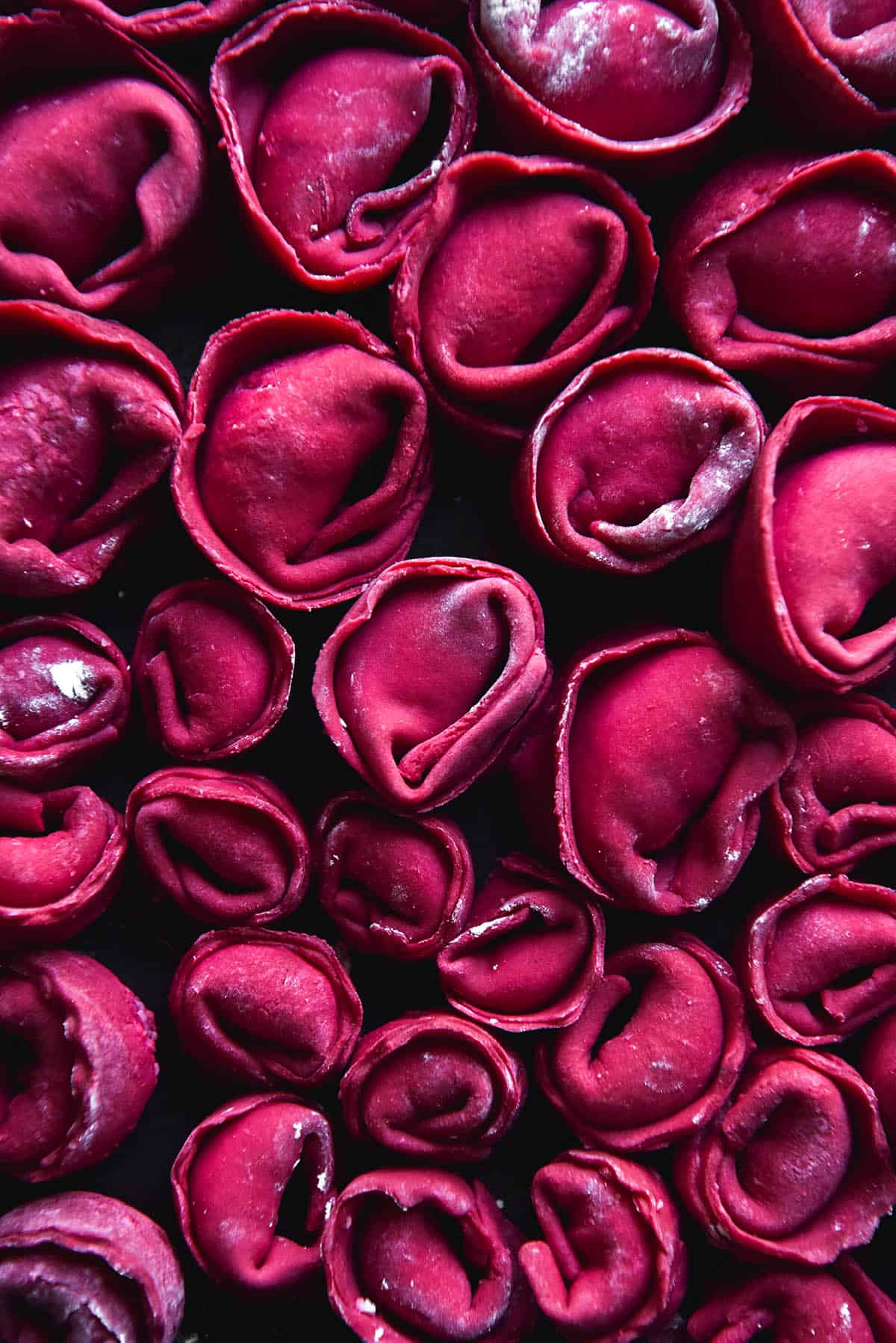
Cooking notes
I’ve found that there are two big determinants of success in cooking up long strands of gluten free pasta. 1) ample flour and loose nests for storage and 2) being attentive to the pasta when it first goes in the water.
I haven’t quite figured out what makes for a good pasta nest, but I have noticed that sufficient flouring makes life easier later on. If the dough is wet once you’ve rolled it out, it will stick to itself when you cook it. There begins a vicious cycle, you’ll spend the cooking time trying to separate it, only to end up breaking it into little pieces. So, a well floured, dry pasta makes for better strands later on.
On the second topic, I’ve found that you really need to spend a bit of time with tongs gently encouraging the pasta to separate once it goes into the boiling water. It likes to stick to itself, so dispersing it into the water early on really helps. Don’t wait a minute or two to do this: do it as soon as the nests hit the water.
Anecdotally, I feel like really well salted water seems to inhibit leeching of the colour a little. So, ensure your pasta water is well salted to assist in retaining that beautiful magenta colour.
As the recipe stands, it only needs 2-3 minutes cooking time. Overcook it and the pasta will begin breaking apart and feeling a little slimy. I find it best to undercook this pasta as opposed to overcooking it. This is particularly important if you’re tossing it through a warm sauce like cacio pepe, as it will continue cooking in the saucepan.

More gluten free pasta dishes
- FODMAP friendly spaghetti aglio e olio
- Vegan, gluten free lasagne
- Quick green protein pasta
- This chilli oil noodles (I use spaghetti when I can’t be bothered making the egg noodles from Intolerance Friendly Kitchen)
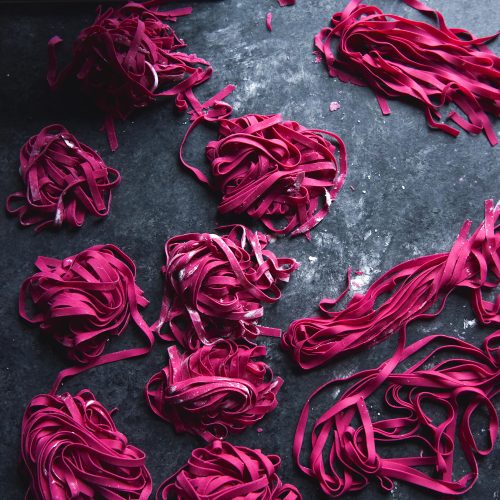
Gluten-free beetroot egg pasta
Ingredients
- 50-100 g roasted beetroot see notes
- 3 extra large eggs
- 60 g (1/2 cup) tapioca flour
- 240g g (1 1/4 cups) brown rice flour
- 1 teaspoon xanthan gum
- water only as necessary
- extra tapioca or brown rice flour for rolling out the pasta
Instructions
- Preheat the oven to 180C or 365F. Note that you can cook the beetroot in the oven while other dishes are cooking too. Rinse, dry and trim 1-2 small beetroots, leaving the skin on. 1 small equates to roughly 50g cooked, and 2 equates to 100g. Very lightly rub them with olive oil and cover in alfoil. Place them on a tray in the oven for about an hour or until a knife slides through easily.
- Set the beetroots aside to cool. When cool, use a paring knife to peel off the skin and chop into small-ish cubes. Add the beetroot and the eggs to a high speed food processor, and blend until completely combined and a vibrant red.
- Combine the flours and xanthan gum in a large mixing bowl. You can also do this on the table (as is traditional) but I always get excited and under-form my flour well. Also, beetroot has a tendency to stain. Either way, form a well in the flour and add in the eggs and beetroot mixture. Use a spoon and then your hands to mix the dough together.
- If you’ve been squeezing and kneading for a while and you’re absolutely convinced the dough will not form a ball, add a teaspoon of water at a time until it does. It is a dry dough, so you only need just enough liquid to bring it into a semi smooth ball. Don’t be lazy, it will make your life hard later on.
- Once you have brought the dough together into a relatively smooth ball, tear off a piece and cover the remaining pasta in cling film or a slightly dampened tea towel.
- Lightly flour the bench with tapioca flour, using as much as necessary, whenever necessary.
- Use your rolling pin to roll the piece of dough thin enough to get through the thickest setting of your pasta machine. After getting it through the thickest setting (mine is a 7) fold it and run it through the machine again. Continue rolling it through on decreased width settings until it’s thin enough for your tastes, noting that it swells during cooking (so go a little thinner than you think). I like to get mine through smoothly at setting 2 or 3 on my Jamie Oliver machine.
- I don’t have a special technique – I keep running the pasta through until it’s smooth and (ideally) has relatively straight edges. You won’t toughen the pasta from rolling, so you can re-roll as often as you see fit. If it’s wonky, you can start fresh. You can also add extra water to very dry pieces that have toughened from being rolled out.
- Once the sheet of pasta is thin enough, put it through the fettuccine cutter. I find angel hair becomes a little gloopy with this dough as it's so thin. Arrange into a little loose nest (dusting with flour if necessary) and set aside.
- Repeat with the remaining pasta dough until you have used it all. From here, you can either cook immediately, refrigerate overnight as nests, or freeze as nests. I find it tastes best fresh, but they’re all delicious regardless.
- To cook, bring a large pot of very well salted water to the boil. Add the pasta and use tongs to gently but thoroughly separate the strands. This is particularly important if you made them the night before, as they have the tendency to stick together. Cook the pasta for 2-3 minutes, until it’s lightly chewy but cooked through. If in doubt, pull it out – the high starch content can make for gloopy pasta if you cook it too long. Slightly undercooked is best (and the eggs will be fully cooked regardless!)
- Leftovers keep well in the fridge for a day or two and can be frozen. The pasta might be a little fragile after cooking and freezing, so I recommend either freezing it raw or using it up within a few days.

Stunning photos!
Hi Georgia, what can I substitute arrows root flour with? As where I live it’s super hard to find. Thank you in advance
Hi Jessica! I apologise, your comment got put in the spam folder. All I’ve tried this pasta with is tapioca flour/starch and glutinous rice flour. I found the version with glutinous rice flour a little gloopy. You could potentially try it with cornflour but I can’t guarantee the results as I haven’t tried it myself. Let me know how it goes if you try a substitute!
Georgia I am interested in your gluten free cooking. I am a gran My beautiful 9 years old granddaughter was found be gluten intolerant, hence I help out with cooking. I recently found some of your recipes. One in particular was a puff pastry; that I plan to make today. Also interested to know what sauce do you serve with your beetroot pasta. My granddaughter is fussy hence a nice sauce? would be lovely.
Hi Marlene! Sorry to hear that your granddaughter is having food concerns, but happy to have you here. I really enjoy a simple brown butter and crispy sage sauce with this pasta – it allows a very subtle hint of beetroot flavour to peek through and doesn’t mask the colour. That said, you can really use whatever sauce you like best. The beetroot flavour is subtle so it really goes with anything! 🙂
Hi, would this receipe work using only brown rice flour ? Or would the texture differ ? Thanks 🙂
Hello Georgia! So beautifull color of this pasta!!! I have to ask how can I replace the eggs? With chia eggs o psyllium perhaps? Thanks for all the recipes you share with US!
Thank you Ivana! I haven’t tested this recipe with an egg substitute yet so I can’t offer any advice. I’m working on a vegan pasta recipe though so I will keep you posted 🙂